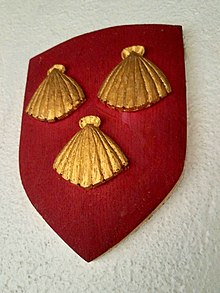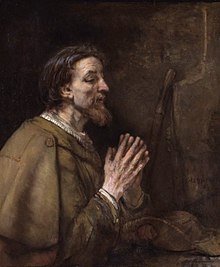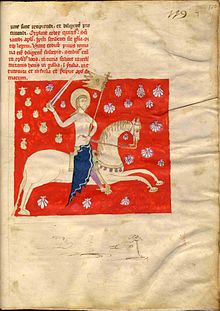James the Great
Saint James the Great | |
|---|---|
 Saint James the Great by Guido Reni | |
| Apostle | |
| Born | Bethsaida, Galilee, Roman Empire, around AD 3 |
| Died | AD 44 Jerusalem, Judea, Roman Empire |
| Canonized | Pre-Congregation |
| Feast | 25 July (Western Christianity) 30 April (Eastern Christianity) 30 December (Hispanic Church) |
| Attributes | Red Martyr, Scallop, Pilgrim's hat |
| Patronage | Places Spain, Guatemala, Seattle, Nicaragua, Guayaquil, Betis Church, Guagua, Pampanga, Badian, , Paete, Laguna, Sogod, Cebu, Philippines and some places of Mexico. Professions Veterinarians, equestrians, furriers, tanners, pharmacists, oyster fishers, woodcarvers. |
James the Great, also known as James, son of Zebedee or as Saint James the Greater (Aramaic: ܝܥܩܘܒ ܒܪ ܙܒܕܝ; Arabic: يعقوب; Hebrew: יַעֲקֹב, Yaʿăqōḇ; Latin: Iacobus Maximus; Greek: Ἰάκωβος; died AD 44), was one of the Twelve Apostles of Jesus according to the New Testament. Saint James is the patron saint of Spain and, according to tradition, his remains are held in Santiago de Compostela in Galicia.
In the New Testament[]
The son of Zebedee and Salome, James is styled "the Greater" to distinguish him from the Apostle James "the Less", with greater meaning older or taller, rather than more important. James the Great was the brother of John the Apostle.[1]
James is described as one of the first disciples to join Jesus. The Synoptic Gospels state that James and John were with their father by the seashore when Jesus called them to follow him.[Matt. 4:21–22][Mk. 1:19–20] James was one of only three apostles whom Jesus selected to bear witness to his Transfiguration.[Matthew 17:1–9][Mark 9:2–8][Luke 9:28–36] James and John[Mark 10:35–45] (or, in another tradition, their mother[Matthew 20:20–28]) asked Jesus to grant them seats on his right and left in his glory. Jesus rebuked them, asking if they were ready to drink from the cup he was going to drink from and saying the honor was not even for him to grant. The other apostles were annoyed with them. James and his brother wanted to call down fire on a Samaritan town, but were rebuked by Jesus.[Lk 9:51-6]

The Acts of the Apostles records that "Herod the king" (usually identified with Herod Agrippa I) had James executed by the sword. Nixon suggests that this may have been caused by James's fiery temper,[2] in which he and his brother earned the nickname Boanerges or "Sons of Thunder".[Mark 3:17] F. F. Bruce contrasts this story to that of the Liberation of Saint Peter, and notes that "James should die while Peter should escape" is a "mystery of divine providence".[3]
Veneration[]

In the Catholic tradition, Saint James is the patron saint of Spain and, according to legend, his remains are held in Santiago de Compostela in Galicia. This name Santiago is the local evolution of Latin Genitive Sancti Iacobi, "(church or sanctuary) of Saint James" (evolved into a personal name in Spanish, and also in Portuguese -Tiago-, with its derivatives Diego/Diogo). The traditional pilgrimage to the grave of the saint, known as the "Way of St. James", has been the most popular pilgrimage for Western European Catholics from the Early Middle Ages onwards, although its modern revival and popularity stems from Walter Starkie's 1957 book, The Road to Santiago. The Pilgrims of St. James.[4] Officially, 327,378 pilgrims registered in 2018 as having completed the final 100 kilometres (62 mi) walk (200 kilometres (120 mi) by bicycle) to Santiago to qualify for a Compostela.[5] When 25 July falls on a Sunday, it is a "Holy Year" (an Año Santo Jacobeo) and a special east door is opened for entrance into Santiago Cathedral. Jubilee years follow a 6-5-6-11 pattern (except when the last year of a century isn't a leap year, which can yield a gap of 7 or 12 years). In the 2004 Holy Year, 179,944[6] pilgrims received a Compostela. In the 2010 Holy Year the number had risen to 272,412.[7] The next Holy Year will be 2021.
The feast day of St. James is celebrated on 25 July on the liturgical calendars of the Roman Catholic, Anglican, Lutheran and certain Protestant churches. He is commemorated on 30 April in the Orthodox Christian liturgical calendar (for those churches which follow the traditional Julian Calendar, 30 April currently falls on 13 May of the modern Gregorian Calendar). The national day of Galicia is also celebrated on 25 July, being St James its patron saint.[citation needed]
James the Apostle is remembered in the Church of England with a Festival on 25 July.[8]
Jerusalem[]
The site of martyrdom is located within the Armenian Apostolic Cathedral of St. James in the Armenian Quarter of Jerusalem. The Chapel of St. James the Great, located to the left of the sanctuary, is the traditional place where he was martyred, when King Agrippa ordered him to be beheaded (Acts 12:1–2). His head is buried under the altar, marked by a piece of red marble and surrounded by six votive lamps.[9]
Spain[]
Mission in Spain and burial at Compostela[]

The 12th century Historia Compostelana commissioned by bishop Diego Gelmírez provides a summary of the legend of St. James, as it was believed at Compostela at that time. Two propositions are central to it: first, that St. James preached the gospel in Spain, as well as in the Holy Land; second, that after his martyrdom at the hands of Herod Agrippa, his disciples carried his body by sea to Iberia, where they landed at Padrón on the coast of Galicia, then took it inland for burial at Santiago de Compostela.[citation needed]
The translation of his relics from Judea to Galicia in the northwest of Iberia was done, in legend, by a series of miraculous happenings: decapitated in Jerusalem with a sword by Herod Agrippa himself, his body was taken up by angels, and sailed in a rudderless, unattended boat to Iria Flavia in Iberia, where a massive rock closed around his relics, which were later removed to Compostela.[citation needed]
According to ancient local tradition, on 2 January AD 40, the Virgin Mary appeared to James on the bank of the Ebro River at Caesaraugusta, while he was preaching the Gospel in Spain. She appeared upon a pillar, Nuestra Señora del Pilar, and that pillar is conserved and venerated within the present Basilica of Our Lady of the Pillar, in Zaragoza, Spain. Following that apparition, St. James returned to Judea, where he was beheaded by King Herod Agrippa I in the year 44.[10][11]
The tradition at Compostela placed the discovery of the relics of the saint in the time of king Alfonso II (791–842) and of bishop Theodemir of Iria. These traditions were the basis for the pilgrimage route that began to be established in the 9th century, and the shrine dedicated to James at Santiago de Compostela, in Galicia in Spain, became the most famous pilgrimage site in the Christian world. The Way of St. James is a network of routes that cross Western Europe and arrive at Santiago through Northern Spain. Eventually James became the patron saint of Spain.[citation needed]
Controversy[]

James suffered martyrdom[Acts 12:1–2] in AD 44. According to the tradition of the early Church, he had not yet left Jerusalem at this time.[12] An argument supporting this assertion is based on the Epistle to the Romans, written after AD 44, in which Paul expressed his intention to avoid "building on someone else's foundation"[Rom. 15:20] by visiting Spain,[Rom. 15:23–24] suggesting that he knew of no previous evangelisation in Hispania.
The suggestion began to be made from the 9th century that, as well as evangelizing in Iberia, James' body was brought to and is buried in Compostela. No earlier tradition places the burial of St. James in Spain. A rival tradition places the relics of the apostle in the church of St. Saturnin at Toulouse; if any physical relics were ever involved, they might plausibly have been divided between the two.[citation needed]
The tradition of Saint James' burial in Compostela was not unanimously accepted, and numerous modern scholars, following Louis Duchesne and T. E. Kendrick,[13] reject it. (According to Kendrick, even if one admits the existence of miracles, James' presence in Spain is impossible.) The Catholic Encyclopedia (1908) registered several "difficulties" or bases for doubts of this tradition, beyond the late appearance of the legend:
Although the tradition that James founded an apostolic see in Iberia was current in the year 700, no certain mention of such tradition is to be found in the genuine writings of early writers nor in the early councils; the first certain mention we find in the ninth century, in Notker, a monk of St. Gall (Martyrologia, 25 July), Walafrid Strabo (Poema de XII Apostoli), and others.
The Bollandists, however, defended it. (Their Acta Sanctorum, July, VI and VII, gives further sources.) A belief in the authenticity of the relics at Compostela was also asserted by Pope Leo XIII, in his 1884 bull Omnipotens Deus.[citation needed]
Medieval "Santiago Matamoros" legend[]

An even later tradition states that he miraculously appeared to fight for the Christian army during the legendary battle of Clavijo, and was henceforth called Santiago Matamoros (Saint James the Moor-slayer). ¡Santiago, y cierra, España! ("St. James and strike for Spain") was the traditional battle cry of medieval Spanish (Christian) armies. Miguel de Cervantes has Don Quixote explaining that "the great knight of the russet cross was given by God to Spain as patron and protector".[14]
A similar miracle is related to San Millán. The possibility that a cult of James was instituted to supplant the Galician cult of Priscillian (executed in 385) who was widely venerated across the north of Iberia as a martyr (at the hands of the local bishops, rather than as a heretic) should not be overlooked. This was cautiously raised by Henry Chadwick in his book on Priscillian;[10] it is not the traditional Roman Catholic view. The Catholic Encyclopedia of 1908, however, is quite cautious about the origins of the cult (see above at "Controversy").[citation needed]
Emblem[]

James' emblem was the scallop shell (or "cockle shell"), and pilgrims to his shrine often wore that symbol on their hats or clothes. The French term for a scallop is coquille St. Jacques, which means "cockle (or mollusk) of [St.] Jacob". The German word for a scallop is Jakobsmuschel, which means "Jacob's mussel (or clam)"; the Dutch word is Jacobsschelp, meaning "Jacob's shell". In Danish and with the same meaning as in Dutch the word is Ibskal, Ib being a Danish version of the name Jakob and skal meaning shell.[citation needed]
Military Order of Santiago[]
The military Order of Santiago, named after Saint Tiago or Saint James, was founded in Spain in the 12th century to fight the Moors. Later, as in other orders of chivalry, the membership became a mark of honor.[citation needed]
Latter-day Saints[]
The Church of Jesus Christ of Latter-day Saints (LDS Church) teaches that in 1829 John the Baptist and later the Apostles James, Peter and John appeared as heavenly messengers to Joseph Smith and Oliver Cowdery and conferred upon them both, and thus restored, the Aaronic and the Melchizedek priesthood authority of apostolic succession to them and thus exclusively on earth to their organization.[15]
In Islam[]
The Quranic account of the disciples of Jesus does not include their names, numbers, or any detailed accounts of their lives. Muslim exegesis, however, more or less agrees with the New Testament list and says that the disciples included Peter, Philip, Thomas, Bartholomew, Matthew, Andrew, James, Jude, John and Simon the Zealot.[16]
See also[]
- Apocryphon of James (also known as the Secret Book of James)
- Camino de Santiago
- Cathedral of St. James (disambiguation)
- Hand of St James the Apostle
- Jacob
- Military Order of Saint James of the Sword
- Our Lady of the Pillar, a Marian/angelic apparition that James had according to tradition
- Peter of Rates
- Saint James, son of Zebedee, patron saint archive
- Santiago Matamoros, lit. "Saint James the Moor-slayer"
- St. James' Church (disambiguation)
References[]
Citations[]
- ^ Camerlynck 1910.
- ^ Nixon 1963, p. 1354.
- ^ Bruce 1964, p. 251.
- ^ Starkie 1957.
- ^ "Estadísticas antiguas" [Archived Statistics]. Catedral de Santiago (in Spanish). Retrieved 26 July 2021.
Estadísticas antiguas
- ^ "Peregrinos en los Últimos Años" [Pilgrims in the Last Years] (in Spanish). Archived from the original on 1 January 2010.
- ^ "La Peregrinación a Santiago en 2010" (PDF) (in Spanish). Archived from the original (PDF) on 29 November 2015.
- ^ "The Calendar". The Church of England. Retrieved 27 March 2021.
- ^ "Photo of altar in the Chapel of St. James the Great". Archived from the original on 27 September 2011. Retrieved 25 July 2016.
- ^ Jump up to: a b Chadwick 1976.
- ^ Fletcher 1984.
- ^ Clement of Alexandria, Stromateis, VI; Apollonius, quoted by Eusebius of Caesarea, Ecclesiastical History V.xviii)
- ^ Kendrick 1960.
- ^ Cervantes 1863, p. 441.
- ^ Doctrine and Covenants 27:12.
- ^ Noegel & Wheeler 2003, p. 86:Muslim exegesis identifies the disciples of Jesus as Peter, Andrew, Matthew, Thomas, Philip, John, James, Bartholomew, and Simon
Sources[]
- Bruce, F. F. (1964). Commentary on the Book of the Acts. Grand Rapids: Wm. B. Eerdmans.
- Camerlynck, Achille (1910). . In Herbermann, Charles (ed.). Catholic Encyclopedia. 8. New York: Robert Appleton Company.
- Chadwick, Henry (1976), Priscillian of Avila, Oxford University Press
- Cervantes, Miguel de (1863). Don Quixote de la Mancha: A Revised Translation Based on Those of Motteux, Jarvis and Smollett. New York: D. Appleton.
- Fletcher, Richard A. (1984), Saint James's Catapult: The Life and Times of Diego Gelmírez of Santiago de Compostela, Oxford: Clarendon, ISBN 978-0-19-822581-2
- Kendrick, Thomas Downing (1960). St. James in Spain. Methuen.
- Nixon, R. E. (1963). "Boanerges". In J. D. Douglas (ed.). The New Bible Dictionary. London: Inter-Varsity.
- Noegel, Scott B.; Wheeler, Brandon M. (2003). Historical Dictionary of Prophets in Islam and Judaism. Lanham, MD: Scarecrow. ISBN 978-0810843059.
- Starkie, Walter (1957). The Road to Santiago. The Pilgrims of St. James. New York: E. P. Dutton. OCLC 28087235.
Further reading[]
- Barreiro, Santiago (2019). "Pilgrims from the land of sagas: Jacobean devotion in medieval Iceland". Journal of Medieval Iberian Studies. 12 (1): 70–83. doi:10.1080/17546559.2019.1705373. ISSN 1754-6559.
- Starkie, Walter (1958). El camino de Santiago: las peregrinaciones al sepulcro del Apóstol (in Spanish). Translated by Amando Lázaro Ros. Madrid: Aguilar. OCLC 432856567.
- Starkie, Walter (1965). The Road to Santiago. The Pilgrims of St. James. Univ. of California Press. OCLC 477436336.
External links[]
| Wikimedia Commons has media related to James the Great. |
- "St. James the Great, Apostle", Butler's Lives of the Saints
- The Life, Miracles and Martyrdom of St. James the Great: Apostle and Martyr of the Christian Church
- The Way of St. James Guide for the pilgrimage to Santiago de Compostela following St. James's footsteps.
- Apostle James the Brother of St John the Theologian Orthodox icon and synaxarion
- History
- St. James the Greater, Apostle at the Christian Iconography web site
- St. James the Greater from Caxton's translation of the Golden Legend
- The patron saint of Spain, celebrated in Santiago in July
- 44 deaths
- 1st-century Christian martyrs
- Ancient Jewish fishers
- Angelic visionaries
- Anglican saints
- Christian martyrs executed by decapitation
- Christian missionaries in Spain
- Christian saints from the New Testament
- Marian visionaries
- People from Bethsaida
- Roman-era Jews
- Saints from the Holy Land
- Twelve Apostles
